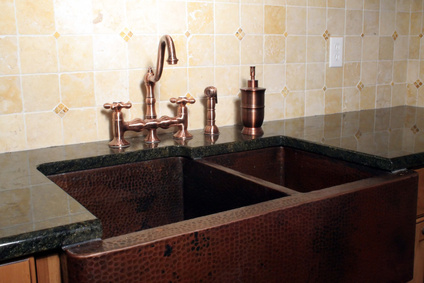Copper Kitchen Sinks
Copper kitchen sinks are an amazing way to add an interesting, yet durable, accent to any kitchen. The most popular these days is the copper farm sink where the front of the sink is exposed, or aproned.
Copper is the first metal man used. It was used from very early on in our history. Due to it's ease of tooling and soft nature. Copper also stands up very well to aging, it patinas as it ages. A patina can go from a shiny new penny to almost black.
Air is what patinas copper. Letting it age naturally gives the best patina, but artificially aging copper will give instant gratification. If you want the shiny copper look and a patina is not desired, waxes can be applied to the surface every couple of months to slow down this process. A lot of elbow work is needed to keep it from aging.
Copper kitchen sinks usually
come in two forms the under-mount and aproned, or a copper
farm
sink.
These sinks come in a wide range of sizes, shapes, and configurations.
Single, double, triple, you name it's available. A copper farm sink is
quite popular these days, and rightfully so, because they are amazing.
-
When buying a copper sink
there are a few things to look for.
- Thickness (or Gauge)
- Where The Metal Came From
- Corner Joining Technique
- The Store You're Buying From
There are two construction techniques used to make these sinks, hammered and stamped.
A stamped sink is stamped by a machine into the desired shape. It's smooth and uniform in appearance. This style shows scratches and dents more readily than a hammered sink. These sinks are a great option for the modern kitchen where symmetry and clean lines are desired.
A hammered copper sink is hammered by hand into the shape desired. There are hammer marks and dimples in the surface and is not perfectly smooth. This technique is a true art-form and is highly desired for the handmade look and feel. It also doesn't show scratches as much as a smooth sink.

For the thickness of the metal, 18 to 14 gauge is the standard for kitchen sinks. The thicker the metal the longer it will last and also the more expensive it will be. Thicker gauges also deaden the noise of the sink better than thinner gauges.
Corner
Joining Methods:
The joining of the corners is also a point to look at. Corners can be
soldered or welded. Soldered joints are not recommended because they
will turn gray and may eventually come apart or leak. Solder
can also
contain lead. Welded seams is the recommended joining technique.
Tips
When Buying:
Buy from a reputable store that will honor their warranties, especially
if you're buying copper sinks online. An as-is sale is not a good way
to buy copper kitchen sinks. Buying internationally is not
recommended
unless the retailer has a good track record in your country.
These sinks are usually expensive, even the cheapest prices, and if there is something wrong with the sink and the store refuses to honor their warranty you could be out a lot of money.
Very Important!!
Where the metal comes from is the MOST IMPORTANT factor when choosing one of these sinks. Metals from some countries have no safety or quality standards and may contain lead. Lead has similar properties to copper and is a much cheaper metal. Lead toxicity can lead to birth defects and learning disabilities in children.
Pure copper has anti-microbial properties and has no lead. Copper sinks should only be purchased from a reputable retailer that does not buy copper from any unregulated countries. If the price is way too low than it's a good bet that it came from unregulated countries and contains lead or other undesirable metals.
Care Of Copper Sinks
The care of copper sinks is very easy. Most of these sink manufacturers recommend using only soap and water to clean the sink. A copper kitchen sink will patina over time, or come with a factory patina, and using an abrasive cleaner can damage this patina. This style of sinks, when inside the home, will NOT turn green.After every use make sure to wipe down the inside of the sink with a soft cotton towel to minimize water spots. Water spots come from areas with hard water and can permanently mark the sink. To lessen this you can wax the inside of the sink with "Renaissance Wax" or similar wax approved for kitchen fixtures.
Waxing only needs to be done 1 or 2 times a year in most cases. Care of copper kitchen sinks with wax is the best way to keep your sink looking new and to prevent stains.
The best test to determine when to reapply the wax is to test for beading. If the water fails to bead on the surface then it's time to re-wax. Waxing is not difficult and only takes a few minutes. Of course hot water will melt and wash away the wax so just be aware of this.
Acidic foods and liquids are also not good for sinks made of copper as they can leave shiny spots in a well patinaed sink. Foods such as pineapple, tomatoes, oranges, and vinegar will all be detrimental to the finish of the sink.
Care instructions should come with your new copper kitchen sink, and if it doesn't, contact the manufacturer to see how they want you to maintain your sink. Some manufacturers have specific requirements as how to care for your sink.




